Barony of Lockhurst
I know it's stretch putting this here, but MicroWiki is trashing a lot of good stuff. I'd appreciate it if this can stay for a while, at least.
| Barony of Lockhurst | |
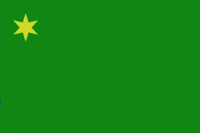
| |
| Motto: | |
| Anthem:Our Beloved Home | |
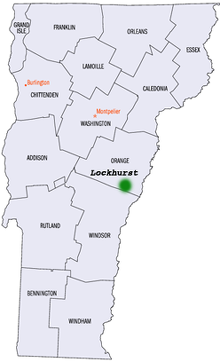
| |
| Capital: | Clancy |
| Largest City: | Clancy (14,650) |
| Official Language: | English |
| Demonym: | Lockhurstan |
| Government: | Democratic Monarchy |
| National Leader: | Lord Matthew Charles Severit I, Baron of Lockhurst |
| Foundation: | 29 March 1838 |
| Land Area: | 47.42 square miles |
| Population: | 19,840 |
| Population Density: | 418.4 per square mile |
| GDP: | US$425,568,000 (2007) |
| GDP per capita: | US$21,450 |
| Currency: | US Dollar; Lockhurst Dollar (2009) |
| Time Zone: | Eastern Standard Time (EST) |
| Memberships: | ANEM |
The Barony of Lockhurst is a small landlocked independently governed autonomous region within the United States. Originally founded as a Transcendentalist intentional community, Lockhurst has held true to many of the tenets of its original charter. Began in 1838 by a group of Unitarians, Lockhurst was governed by five trustees for the first seven years. By 1845, Francis Severit, one of the founding trustees, had obtained a higher degree of influence in the community, leading to his declaration that Lockhurst was to be a Barony in perpetuity. The Severit family has continued to rule Lockhurst to this day.
History

During the winter of 1836-37, a small group of Transcendentalist thinkers in Boston decided to create an intentional community to espouse their Unitarian beliefs and to live communally with nature. By March 1838, the group, now consisting of six families and eleven single individuals, purchased five hundred acres of land in Vermont on which to begin their social experiment. On 29 March 1838, the participants moved to the newly named Lockhurst Farm. The first year was difficult, as fields needed planting, houses and outbuildings constructed, and livestock tended. However, the first families survived through the first winter and set out to make life easier for themselves in the second year.
Over the first seven years, the community grew in population as children were born and other Transcendental thinkers joined. By 1845, the population had risen from the original thirty to one hundred twenty two. The board of trustees had gradually purchased neighboring tracts of land during those years to sustain the newcomers, until Lockhurst covered 3,870 acres in 1845. However, the decline in Transcendental thought in the United States began taking its toll on the small community. Many other experimental communes had disbanded throughout the 1840s and many major Transcendentalists had passed away. To ensure the survival of the community, Francis Severit declared that Lockhurst was to be an autonomous Barony ruled by himself as Baron and a group of trustees. They would stand by the values and beliefs written into the charter and protect the community from disbandment.
The population varied greatly throughout the next twenty years, but had reached five hundred by 1865. The Baron initiated the purchase of additional land surrounding Lockhurst, expanding its size to 5,650 acres. In 1863, he bestowed upon the four trustees the title of Baronet and renamed the board of trustees the High Council. In 1869, the Baron's wife, Rebecca, died of pneumonia. He never recovered from her death, but continued to govern the Barony until his own death in 1878.
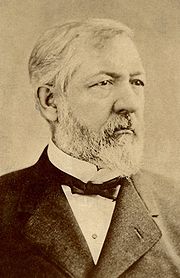
After his death, the High Council debated as to who would succeed him as Baron, a debate that was quickly ended by Francis' eldest son, David. He claimed the title and continued his father's tradition of Transcendental governance. The later decades of the nineteenth century proved prosperous for Lockhurst, with an influx of residents and a new era of wealth as the new Baron introduced modern farming and industrial techniques to the Barony. He embraced environmentally friendly industrial methods, industrializing the community without creating unnecessary pollution or harm to nature. He also introduced new construction methods to allow a more concentrated population density without sacrificing quality of life. By his death in 1903, the population of Lockhurst had grown to 2,325 and covered an area of 7,500 acres.

Lord David's eldest son, William, succeeded him as Baron, continuing his father's modernization of Lockhurst. He authorized the purchase of ten communal tractors in 1908, ordered the construction of a modern medical center in 1911, and instituted mandatory militia training in 1915. In 1921, Lord William restated the autonomy of Lockhurst as an independent realm within the United States. During the 1920s, he democratized the government, increasing the membership of the High Council to twelve and creating the larger Town Meeting as the representative voice of the citizenry. He also chose a Cabinet to advise both himself and the High Council. After the stock market collapse in 1929, a new wave of immigrants moved to Lockhurst in search of a simple, affordable life. By the time Lord William died in late 1930, the population of Lockhurst had risen to 4,478.
James Severit succeeded his father in 1930 and immediately set forth in purchasing additional land to support the increasing population. He was able to acquire 3,650 acres over the next two years, but could not keep up with immigration. Facing a food crisis, he instituted an immigration restriction in September 1932, turning away all new immigrants. This proved popular within the community, but unpopular amongst potential immigrants who had nowhere else to go. On 23 May 1933, Lord James was assassinated by an immigrant who had been turned away from the community. His son, Charles, immediately succeeded him as Baron.
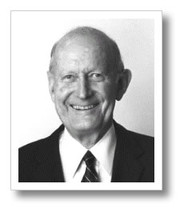
As Baron, the young Lord Charles maintained his father's policy of isolation until he was able to acquire an additional 4,000 acres in 1937. On 1 January 1938, the immigration ban was lifted, prompting a sudden influx of 1,300 immigrants during 1938. On 29 March 1938, the citizens of Lockhurst celebrated their centennial with an official holiday. In 1941, Lord Charles created the Lockhurst Mounted Police to maintain security in the Barony during the Second World War. Their charter was extended after the war, and they continue to police Lockhurst to this day. In 1950, Lockhurst College was founded to further the study of Transcendental thought. Originally open only to citizens of Lockhurst, the college began accepting students worldwide in 1959.
During the next two decades, a renewed interest in Transcendentalism and intentional communities sparked another mass wave of immigration by members of the counterculture. Once again facing limited expansion space, Lord Charles authorized the purchase of 12,000 acres of woodlands adjacent to Lockhurst. The immigration surge pushed the population to 11,920 in 1980. The use of ecological urban planning during the previous century had allowed the majority of the population to live in only a small portion of the Barony, with smaller communities dotting the landscape. In 1982, Lord Charles finally outlawed the use of gasoline powered automobiles in Lockhurst, but subsidized the purchase of smaller, environmentally friendly electric autos and tractors.
During the late 1980s, Lord Charles again increased the membership of the High Council to 16, and the Town Meeting to 60. Despite his advanced age, he remained in good health into his eighties and was able to continue governing. In 1992, he attracted the first of several high-tech and internet businesses to Lockhurst in a move toward pollution free industry. With the economy booming, the medical center was upgraded to a hospital, new schools were built to replace aging ones, and a recreational center was constructed. However, a fall in 1998 slowed Lord Charles down, and in 2001 he turned over daily governance to his son, Matthew.
The economic downturn and rising energy prices of the twenty-first century slowed the growth of Lockhurst, but did not stop it. When the housing bubble popped in 2007, immigration again increased, prompting another land acquisition of 3,200 acres, bringing the Barony to its current size of 30,350 acres (47.42 square miles). Upon Lord Charles' death in 2006 at age 97, Matthew became Baron and continued to guide the small nation. By January 2009, the population of Lockhurst had grown to 19,840, with a population density of 418.4 people per square mile.
Geography
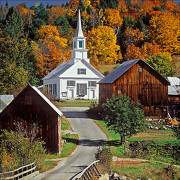
The Barony of Lockhurst is completely landlocked by the State of Vermont within the United States. It covers an area of 30,350 acres or 47.42 square miles. The topography of Lockhurst is mostly hilly with only a few areas of flatland. The Barony was originally heavily vegetated with old growth forests, but has been forty-six percent cleared for habitation and farming. Farmland covers approximately thirty percent of the total land area. Lockhurst is the 223rd smallest autonomous region on the planet, between Saint Martin and Norfolk Island.
The capital of Lockhurst is Clancy, the original settlement in the Barony, with a population of 14,650. The rest of the population resides in smaller communities throughout the Barony, including Newtown (2,100), Mauntan (1,350), Silvester (700), and Danton (480). The population density is greatest in Clancy, and is much lower in the farming communities. The smaller communities are centered around their particular industries, such as Danton's agricultural base and Mauntan's textile mills. Thus the architectural style and layout of the towns vary substantially.
2.9 percent of the land area of Lockhurst is covered by water, an area equivalent to 880 acres (1.375 square miles). The water is concentrated primarily in ponds, creeks, and the Lord David Severit Reservoir, which provides the majority of potable water for the Barony.
Government
Originally, Lockhurst was governed by a five member board of trustees until 1845, at which time the current form of government was instituted.
Executive
The Executive branch of the government consists of the Baron of Lockhurst and the Baronial Cabinet. The Cabinet membership varies by Baron, but generally consists of a Minister of Finance, Foreign Minister, Defense Minister, Minister of Agriculture, Minister of Commerce, Solicitor, Minister of Education, and Environmental Minister. The Cabinet manages the various administrative ministries of the government on a daily basis and advises the Baron and High Council on policy.
Legislative
The Legislative branch of government consists of the High Council and the Town Meeting. The High Council was formed from the original board of trustees and consists currently of sixteen members. It writes policies and laws for the Baron's approval or veto. The High Council meets in session once a month. Before 1925, Councilmen were appointed by the Baron and served for life or until retirement. Since 1925, Councilmen are elected by the general population and serve a five year term. They receive token compensation for their service, currently US$100 per month while in office. Until 1925, Councilmen received the bestowal of a Baronetcy upon their appointment. From 1925 to 1935, they were knighted by the Baron, but no longer received a Baronetcy. Since 1935, Councilmen have not been bestowed any additional title or peerage. Therefore, all current Baronets are descended from pre-1925 Councilmen.
The Town Meeting was formed in 1925 as a representative legislature for the citizenry. There are currently 60 members of the Town Meeting, called Meetmen, who meet once every quarter for three days to discuss, debate, and write policy for submission to the High Council. Meetmen are elected by the general population and serve a two year term. They receive compensation of $50.00 per day while in session plus $50.00 per day for expenses.
Judicial
Judicial affairs were originally handled by the Baron and High Council until 1923, when Lord William established a judicial branch consisting of two levels. The lower level is the Justice of the Peace, of which there are twelve. The Justice of the Peace decides minor civil disputes between opposing parties locally on a part-time basis. They are also registered Notaries. Justices of the Peace are appointed by the Baron with advice from the Solicitor and serve a ten year term or until resignation. They do not necessarily have to hold a law degree, but most do. Seven of the twelve Justices of the Peace are located in Clancy, with the rest located throughout Lockhurst.
The second level is the Baronial Court, consisting of three Judges that sit in panel over major civil suits and all criminal trials. They hold trial every Monday with a second session on Tuesday if necessary. Judges are appointed by the Baron and serve for life or until retirement. The most senior Judge by service is tasked with assigning cases to public solicitors. Judges are required to hold a law degree from an accredited university.
Administrative Division
Lockhurst is divided into thirty townships of one thousand acres each. Membership in the Town Meeting is calculated by the number of townships multiplied by two, making sixty Meetmen. However, Meetmen are elected at large rather from individual townships as many are uninhabited. The Barony is small enough that local government is almost unheard of; instead, the Baronial government administers all levels of governance.
Foreign Affairs
The Barony of Lockhurst maintains friendly, but informal, relations with the United States, Canada, and many European nations. At times, Lockhurst sends a diplomatic representative to the capitals of various nations to represent their interests, but often does not have representation with these nations. Currently, Lockhurst has Consuls in Washington D.C. and Paris.
Economy
The 2007 Gross National Product for Lockhurst was US$425,568,000, with a per capita GNP of US$21,450. The dominant industries are high tech, agriculture, logging, tourism, and cloth goods. Before 1990, the dominant industry was agriculture, with sixty-five percent of the workforce employed in farming or ranching. Today, only twenty-five percent of the workforce remains in agriculture, with another thirty-six percent working in the high tech industry. Tourism has increased in the last twenty years as eco-tourism has become more popular. The per capita GNP has risen considerably since 1980, from US$6,791 to US$21,450 in 2007, an increase of over three hundred percent. The Lockhurst government has maintained a large annual surplus in its budget since 1973.
Numismatics
The Barony of Lockhurst has coined its own currency at times in its history, such as between 1849 to 1866, 1874 to 1881, 1916 to 1919, and 1931 to 1948. In 1938, the Baronial Numismatic Society coined a commemorative coin for the centennial celebration, coining another in 1988. Due to the worldwide economic crisis and currency devaluation, Lord Matthew has authorized the printing of a new series of currency in 2009.
Armed Forces
Since 1915, Lockhurst has mandated militia training for all citizens between the age of eighteen and forty-five twice a year. In 1941, the Lockhurst Mounted Police were created to patrol the growing nation and ensure the safety of its citizens and property. Since 1941, the Mounted Police have served as the primary armed forces of Lockhurst, although militia training is still mandatory from age eighteen to twenty-six.
Demographics
A census of the citizens and residents of Lockhurst is taken every five years. Due to the small population, the census usually takes only weeks to complete and accounts for the entire population. The first census was taken in 1868; the last was taken in October 2008. According to the 2008 census, the total population of Lockhurst is 19,840. As in many agrarian societies, the birthrate is higher than in developed nations, resulting in a younger population than average. 32% of the population is age eighteen or younger, 54% is between the ages of nineteen and sixty-four, and 14% age sixty-five or older.
The density of Lockhurst as a whole is 418.4 person per square mile, but is much higher in populated areas. The ratio of men to women has remained statistically high since the earliest days of the Barony since there are always more single men than women residing in Lockhurst. In 2008, the ratio was 112 men for every 100 women, considerably down from the 1868 ratio of 137 men for every 100 women. The population growth over the last decade has averaged around 2.3% per year.
Education
Education for all Lockhurst citizens is free for all levels, including adult education. Highly focused on education, Lockhurst children begin their schooling at the age of three in separate Kindergardens to the age of six. From age six to thirteen, students attend primary school before moving on to secondary school until age seventeen. Upon completion of secondary school, students can choose to attend college or vocational training. Lockhurst College offers two or four year degrees in a multitude of subjects. Vocational training consists of a year of classroom work and a year of field work, and guarantees a position upon completion in the student's selected industry.
Healthcare
A large portion of the annual budget always goes toward the healthcare system in Lockhurst. The first medical center was constructed during the early years of the Barony, which now offers residents two hospitals, three medical centers, and an urgent care facility. Although the population of Lockhurst has not trended towards an increasingly aging population, the growing number of citizens over sixty-five has prompted the construction of two long term care facilities. However, the health department of Lockhurst attempts to keep the elderly at home as long as possible for a better quality of life. With this healthcare system in place, the average life expectancy of citizens has risen higher than the global average to 86 for women and 81 for men.
Transportation
In 1980, Lord Charles outlawed all vehicles with combustible engines from Lockhurst. Only electric, compressed air, or hydrogen powered vehicles are allowed on Lockhurst roads. The first roads were the dirt farm paths that were constructed in the 1840s. The main thoroughfare through Clancy was cobbled in 1881, but the remaining roads were not paved until the 1920s. Due to the small size of the Barony, a limit was placed on the number of private vehicles in 1953. In 1955, a trolley service was began between all the communities in Lockhurst to reduce the traffic that had begun to clog the road network. The electric trolley system continues to run throughout Lockhurst to this day. Personal vehicle registration is limited to 2,500 at any time.
Lockhurst is also served by a small municipal airport outside of Clancy with a single 3,200 foot runway.
Culture
Lockhurst has a long, rich cultural tradition that each of its citizens share. Still a strong Transcendentalist nation, the Barony has maintained an old fashioned, nineteenth century tradition for nearly two centuries that couples nicely with the modernity that the Barons have fostered.
Cuisine
Since Lockhurst produces ninety percent of the food consumed by its citizens, residents are very proud of their traditional dishes, and the restaurants of Lockhurst are very popular amongst visiting New Englanders. The most popular dish in the Barony is roast beef with potatoes, carrots, celery, and cabbage, served with a pan of cornbread, which is cheap and filling. Other popular dishes include corned beef with cabbage and vinegar, stewed beef, lamb with mint jelly, and breaded pork chops. Because Lockhurst produces the majority of the food it consumes, food prices are considerably lower than the nations surrounding it. A family of four can be fed for a week for under US$40.
Media
Lockhurst is served by one daily newspaper, the Clancy Journal, and two weekly newspapers, The Transcendentalist and the Lockhurst Herald. A local radio station broadcasts from Clancy on an AM frequency, WBOL. The government founded a television station in 1952 to broadcast emergency announcements to citizens, but sold the station in 1956 to private investors, who operate the station as the Lockhurst Broadcasting Service. Other radio and television stations are received from outside the nation.
Music
The music scene in Lockhurst is still in fledgling status, with very few citizens involved in the industry. An opera house was built in 1895, but was converted into a movie theater in 1933. The Baronial Ampitheatre, constructed in 1947, holds several concerts each year by local bands. A group of citizens formed the Clancy Philharmonic in 1988, and perform regularly at the Ampitheatre as well.
Literature
Lockhurst has been the home of a multitude of writers over the last hundred and seventy years, including many well-known Transcendentalist writers. Jerome Harding, a famous Transcendental philosopher and author, resided at Lockhurst from 1843 to 1850. Award winning poet Mary Plummer was born in Clancy in 1867 and lived there until 1901. Twentieth century Transcendental author Michael Lindner moved to Clancy in 1912, producing his most important works during the 1920s and 30s, before his death in 1946. Novelist Nathan Byrnes lived in Lockhurst from 1934 to 1937, writing his famed A Shared Life there in 1936. Journalist Nancy Graines was born in Clancy in 1938, living there until 1957. More recently, Lockhurst has been the home or birthplace of novelist Martin Mandover, poet Jean Norton, and philosopher Dr. Thomas Grant.
Baronial Bard
In 1917, Lord William appointed renowned Lockhurst poet Gregory Laxx as the Baronial Bard, or poet laureate, for the Barony of Lockhurst. He composed the poem which continues to serve as the national anthem, Our Beloved Home, in 1919, and composed six more national poems before his death in 1941. Lord Charles appointed a second Baronial Bard in 1942 from a selection of eight Lockhurst poets, choosing Helen Haines. She composed three epic poems for the Baron during her tenure, which lasted until 1968. Lord Charles then appointed one of the 1941 runner-ups, Daniel Porter, as the Bard. He composed thirteen poems between 1968 and 1977 for the Barony. Richard Bloom became the next Bard, composing only one poem during his three year tenure. In 1980, Lord Charles appointed the thirty-one year old Fiona Quinn as Bard. She continues to hold the post and has composed twenty-eight poems, one each year.
Art
Art, especially that depicting natural scenes, is an important part of Lockhurst culture. The Museum of Natural Art was opened in Clancy in 1972 by Lord Charles, being a gift by philanthropist Sir Henry Simms. During the first decade of Lockhurst's existence, painting and sculpting were the main leisure activities performed by Lockhurst residents. Many examples of this early work were preserved in the homes and offices of Lockhurst into the twentieth century, and were donated to the museum for public display. Many Lockhurst citizens became semi-famous in their own right for their artwork, among them painter Martha Haines, sculptor George Braddoc, painter Patrick Harrison, quilter Sarah Mason, painter Adam Kentram, and sculptor David Hendricks. In the late twentieth century, the selling of Lockhurst produced traditional artwork became a major industry. Modern artists Lane Evans and Christina Dananavan have made substantial fortunes by selling their landscapes of the Lockhurst countryside. Portraitist Eugene Nash also made a name for himself for his portraits of Lord Francis (1875), Lord David (1883), and Lord William (1910). His son, George Nash painted the portraits of Lord William (1927), Lord James (1932), and Lord Charles (1938, 1945, 1960). Old-style photography has also risen in popularity in Lockhurst, with photographer Kenneth Brody leading the movement in recent years.
Sports
Physical activity has long been important to the citizens of Lockhurst as most worked at laborious professions. Even now, Lockhurst residents are fitter and more physically active than the citizens of any other nation. Intramural sports have long been popular amongst the young, and are gaining popularity amongst the middle aged as well. Although the Barony does not support any professional sporting teams, several amateur teams exist. The Clancy Communards are an amateur baseball team that play at the Clancy Sports Park. Soccer has become increasingly popular, leading investors to organize FC Lockhurst as a semi-professional team. Local schools and community centers offer baseball, volleyball, softball, basketball, tennis, soccer, and rugby on an intramural basis.